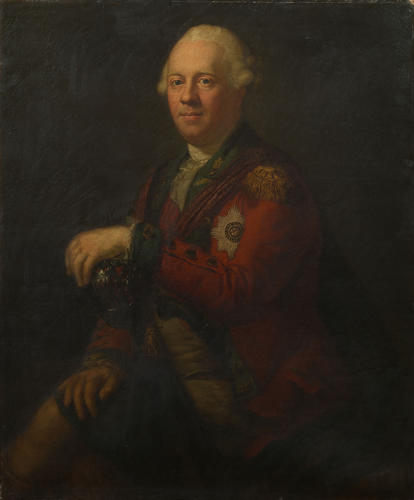Lieutenant-General Sir Robert Murray Keith (1730-1795) 1770
Oil on canvas | 104.4 x 86.4 cm (support, canvas/panel/stretcher external) | RCIN 401523
-
In a letter home to his father from Dresden on 30th December 1769 Lieutenant-General Sir Robert Murray Keith wrote 'I have a very extraordinary commission to give you, which I am afraid you will hardly be able to execute without the help of honest Jock R—— or some such Highland oracle. The Elector has more than once expressed a curiosity to see me in the dress of my quondam corps. I intend to surprise him with it at one of his reviews, in spring. But to be completely in order, I want a handsome bonnet, a pair or two of the finest knit hose, and a plaid of my colours, sewed and plaited on a waist belt. If to this you are so good as to add a handsome shoulder-belt and buckle, and the hilt of an Andrew Ferrera, I shall be enabled to show my nakedness to the best advantage' (Gillespie Smith 1849, 121-2).
1769 Lieutenant-General Sir Robert Murray Keith was a British soldier and diplomat. His knowledge of German and friendship with William Pitt the Elder and Colonel Henry Seymour Conway enabled him to be appointed Envoy-extraordinary to Saxony in 1769, following that he served in Denmark and then in Vienna. The dress described in Keith's letter is presumably that illustrated in this portrait of the Scottish nobleman by Anton Graff painted in Dresden in 1770. It depicts him wearing 'a red coat with a cape collar and green facings, button-loops of oak-leaf shape embroidered with gold thread, a white or pale buff waistcoat, a great plaid of dark green and black tartan, crimson sash, and red and white hose'. His bonnet with its black cockade and black ostrich tips lies beside him. The star of the Knight of the Order of the Bath must have been added to the painting at a later date, since he did not receive it until 1772' (we thank A. V. B. Norman for his article on the subject). Johann Ernst Mansfeld made an engraving in Vienna in 1779 which demonstrates these attributes even more clearly. A more informal portrait by Nathaniel Dance, probably painted in 1772 and belonging to the Earl of Crawford and Balcarres, also shows the coat.
Known as the Van Dyck of Germany, Anton Graff was a prolific portrait painter, executing some 2000 paintings and drawings, 100 of which were self-portraits. An esteemed member of Prussian society, perched on the threshold between the Enlightenment and Romantic periods, Graff painted many of the most important figures of German history, including Friedrich Schiller, Heinrich von Kleist, Johann Gottfried Herder, Gotthold Ephraim Lessing and Moses Mendelssohn. Though a great number of his commissions came from the middle classes, Graff's most famous portrait was of the Prussian King Frederick the Great and he also painted the Russian, Polish and Baltic nobility. In 1778 he ended a brief account of his own life with "I owe Berlin much", meaning commissions from the Prussian court.
Graff is a connoisseur of the face, employing a theatrical, spotlit effect which teases out an enhanced psychology from his sitters. His earlier portraits are painted on monochrome backgrounds devoid of context, but his later works begin to introduce setting and surrounding objects. The emotional intensity of some of his portraiture is seen as proto-Romantic and certainly had an impact on his pupil Philip Otto Runge. Some of his later formal innovations, such as the use of impasto, are said to have had a bearing on Realism and Impressionism.
Born in northern Switzerland, Graff was a pupil of Johan Ulrich Schellenberg in Winterthur. In 1746 he moved to Bavaria and eventually became assistant to the court painter in Ansbach, Leonhard Schneider, with whom he produced large numbers of copies of a portrait of Frederick the Great (presumably by Antoine Pesne). In 1766 he was appointed court painter to Dresden and teacher for portrait painting at the city's Art Academy. He was also a member of the Art Academies in both Vienna and Munich.Provenance
Bequeathed to King Edward VII by Mrs JA Maidstone-Smyth, 1903
-
Creator(s)
Acquirer(s)
-
Medium and techniques
Oil on canvas
Measurements
104.4 x 86.4 cm (support, canvas/panel/stretcher external)
127.4 x 109.4 x 10.8 cm (frame, external)
Category
Object type(s)
Alternative title(s)
Lieutenant-General Sir Robert Murray-Keith (1730-1795)








